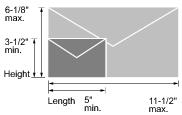Preparing covers
You've decided what kind of postmark you are looking for, you've found one you want, and you've gotten the stamps you are going to use. Now you want to send an envelope in for cancellation. (Am I wrong, and what you want is to send in a postcard? Feel free to move along to the next section.)
Size matters
The USPS Domestic Mail Manual ("the DMM") is very clear on the issue of permitted dimensions for an envelope that can be sent by First Class letter mail. It must be:
- from 3½ to 6⅛ inches high
- from 5 to 11½ inches long
- from 0.007 to ¼ inches thick

Image taken from the USPS DMM
Yes, 0.007" is a strange, very specific number, but an empty commercial envelope is thicker than this, so we're good from a collecting perspective.
Selecting the right envelope
You can use anything within that rectangular size range to service as a cover, but the vast majority of collectors use #6-¾ envelopes. That's the size most albums are made for. That's probably the size you want to use. These envelopes are 3⅝ by 6½ inches, fitting nicely inside the size constraints.
But hold on. Don't run to the office supply store just yet. There's more you need to care about. You can get totally nerdy about the details, but it comes down to
- You want your covers to survive for a long time
- You want your covers to take a cancel without smudging
The holy grail of envelopes is to find a supplier of 100% cotton envelopes with ungummed, tuckable flaps that are acid-free in both their material and adhesive and are certified for laser printing by the USPS. This quality used to be easier to find. It is almost impossible now. I know of only one source of philatelic-quality #6-¾ envelopes: The Universal Ship Cancellation Society, which is kind enough to offer these envelopes to the public. As of this writing, the envelopes are $0.15 apiece with the minimum order (and get cheaper as your order size increases), and Priority Mail shipping is included. They are the only source I now use.
Preparing your envelopes
An empty envelope is too easily mangled on its trip home (or by a hurried postal worker), so you want to insert something to stiffen the envelope. A cool little trick is to use comic book boards, which designed to help collectors store comic books safely. If you shave a bit off one side of a "current size" board with a guillotine paper trimmer, so that it ends up 161mm wide, then cut it along the other axis into exact thirds, you end up with 161mm x 90mm cards that fit the inside of a #6-¾ envelope perfectly. Why those and not any old index card? For the same reason we considered when we were selecting envelopes a few moments ago: the stuffers need to be acid-free and archival. Comic book boards are; index cards are not.
The envelopes you will (or at least should) be using do not have adhesive on the flaps, and you wouldn't want to seal them anyway, so you have a few options after you stuff your envelopes. You can tuck the flaps into the envelopes, if you have the dexterity to do that without creasing the flaps. You can leave the flaps open and hope that the person servicing the cover is careful with the flap. Or you can use a little removable adhesive label (not tape!) and remove it immediately upon receiving your covers back in the mail. I usually choose between the latter two, but in my experience leaving the flaps flapping rarely causes problems.
Stick-to-itiveness
If you are using stamps with water-activated gum (rather than pressure-sensitive self-stick stamps), don't trust the adhesive. Even if it was good to begin with, if you are using fifty-year-old stamps, the adhesive properties have often degraded significantly. Instead, glue them to the envelope. But — you guessed it — not with any adhesive. You want a strong, permanent, acid-free-and-archival adhesive. I use Elmer's E4016 CraftBond Extra Strength Glue Sticks, and they work really well, but any permanent adhesive marketed for scrapbooking should work.
Art time
You can definitely send blank envelopes with a stamp or two for servicing with a postmark — I've done that plenty of times — but it's way more fun to express your creativity and decorate them. You can come up with a nice design and laser-print it onto your envelope; you can paint or draw right onto the envelope; you can glue pieces of cut paper onto it; basically anything that doesn't cause a big bulge in the envelope and won't deteriorate over time is a good choice.





